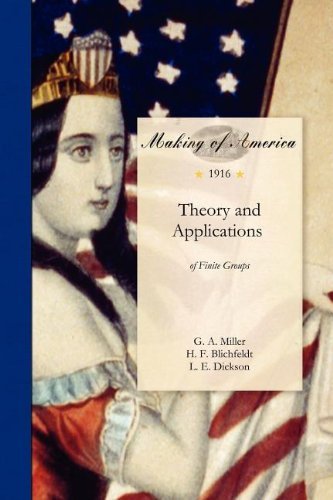
Fortell venner om denne varen:
Theory and Applications of Finite Groups
G. Miller
Bestillingsvarer
Theory and Applications of Finite Groups
G. Miller
This historic book may have numerous typos and missing text. Purchasers can download a free scanned copy of the original book (without typos) from the publisher. Not indexed. Not illustrated. 1916 Excerpt: ...contains negative substitutions. 2. The group of isomorphisms of the symmetric group of degree n, nC,, can be represented as a transitive substitution group on the n(n--1)/2 letters corresponding to the transpositions of the symmetric group. When / is thus represented, it is a simply transitive primitive group whenever «4. Suggestions: Use the theorem that the symmetric group of degree «, and «2, is its own group of isomorphisms, and that it has no outer isomorphisms. See § 65. 3. Prove that if the / of the quaternion group is represented as a substitution group whose letters correspond to its operators of order 4, it will be conjugate with the group in the first of these exercises which involves negative substitutions. 64. Doubly Transitive Substitution Groups of Isomorphisms. If l is doubly transitive on letters corresponding to operators of G, each of these operators generates a cyclic subgroup (s) which is transformed into itself under the holomorph of G by a subgroup composed entirely of operators which are commutative with s; for, if a complete set of conjugate operators of G under / includes at least two powers of the same operator, the operators of this system must be transformed according to an imprimitive group. Suppose that si and s2 are two operators of G which correspond to letters of /. We may assume that Si, 52 are non-commutative; for, if all such operators were commutative, G would be abelian and hence the order of every operator of G would divide 2. Since this case is so elementary, we shall exclude it in what follows and hence we shall assume that si, S2 are non-commutative. If si, 52 correspond to themselves in a given automorphism of G, all the operators of the subgroup generated by si, s must also correspond to them...
| Media | Bøker Pocketbok (Bok med mykt omslag og limt rygg) |
| Utgitt | 8. mars 2012 |
| ISBN13 | 9781458500700 |
| Utgivere | University of Michigan Libraries |
| Antall sider | 410 |
| Mål | 150 × 23 × 226 mm · 603 g |
| Språk | Engelsk |


